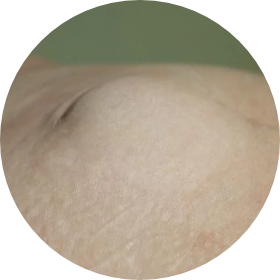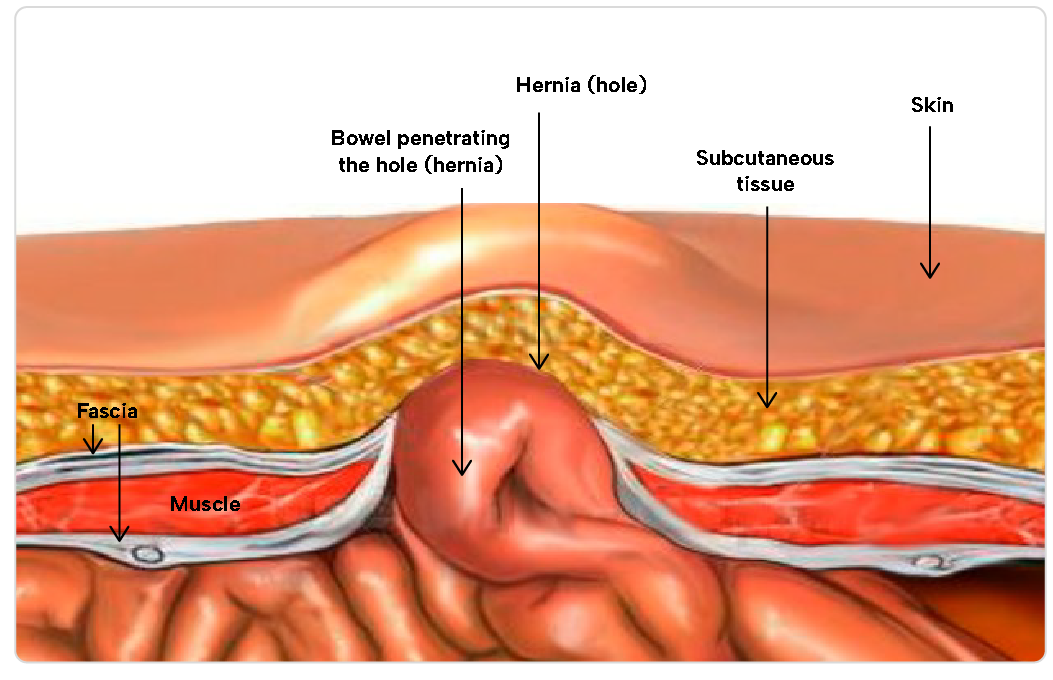Understanding Hernias

What is a Hernia?
An abdominal hernia occurs when there is a weakness or defect in a muscle and its covering tissue, called fascia, that allows a hole to occur through which fat or internal organs (such as bowel) protrude. This can result in a lump and/or pain over the hole, which are the most common symptoms of an abdominal wall hernia.
Where do Hernias occur?
Hernias through the abdomen muscles (abdominal wall) can occur anywhere from the rib margin to the bones of the pelvis and from the middle of your abdomen to the muscles on your sides. They can also occur through the some of the layers of your back muscles. Occasionally, hernias can also occur through muscles/fascia in other places including the diaphragm (hiatus hernia) or inside the abdomen (internal hernia). The different types of hernias are discussed below.
An abdominal hernia occurs when there is a weakness or defect in a muscle and its covering tissue, called fascia, that allows a hole to occur through which fat or internal organs (such as bowel) protrude. This can result in a lump and/or pain over the hole, which are the most common symptoms of an abdominal wall hernia.

What are the consequences of having a Hernia?
The symptoms and consequences of having a hernia are variable. Some people have no symptoms at all and their hernia may be diagnosed whilst they are having a scan for another reason. The most common symptoms are a lump or bulge over the area of the fascia/muscle hole and/or pain. These symptoms may come and go depending on whether the hole has something in it. Over time the lump or bulge may become bigger as the hole is stretched and increases in size, this will allow more fat and organs into the hole.
Occasionally the bowel can get trapped in the hernia and this is a more serious problem as it can cause a blockage of the bowel or cut off the blood supply to this section of bowel. These problems can cause the bowel to die or become “gangrenous” and this can require emergency surgery. Because of these risks, once you have or suspect a hernia you should see a General or Hernia Surgeon to discuss the best treatment options for you. Your GP can provide you with a referral.

How is a Hernia diagnosed?
Hernias can be diagnosed clinically, from your history and examination, or by imaging. Depending on the type of hernia, diagnostic imaging can range from simple X-rays and ultrasound to more complex CT scans and MRI. At the Australian Hernia Centre we do in-rooms ultrasound as a standard part of our initial assessment so we can best diagnose and understand the characteristics of your hernia. When required we will refer you for the additional diagnostic imaging that we require and we use specific radiologists with expertise in the abdominal wall and hernia assessment to best diagnose your hernia condition. You do not need any imaging done prior to your appointment.

What to expect from your Consultation?
At The Australian Hernia Centre our specialist surgeons will evaluate you from your history and physical examination. They will use our in-house ultrasonography as well as specialist diagnostic imaging to accurately diagnose your hernia condition. They will discuss the findings and the treatment options for you and your hernia. They will co-ordinate all aspects of your care, including your surgery. After surgery, our Surgeons and extended AHC team support you through all aspects of your recovery and rehabilitation and will monitor your progress closely to ensure you achieve the expected outcome. We take pride in the care and support we give our patients and address your individual needs at all stages of your journey including diagnosis, treatment and recovery.
Common Hernias

Inguinal Hernia
Epigastric Hernia
These are hernias that develop between the rib cage and umbilicus (belly button). They can be small or large and tend to contain fat. They present with a bulge and can be quite painful as the herniated fat moves in and out of the hernia hole. More Information >>
Umbilical Hernia
These are hernias through the umbilicus (“belly button”) that can contain fat and/or bowel. Hernias adjacent to the belly button are known as para-umbilical hernias. More Information >>
Incisional Hernia
Any hernia or protrusion through part or all of a previous operation scar. They can be small or very large and large hernias can contain many different abdominal organs. More Information >>
Less Common Hernias
Femoral Hernia
This is the other “groin” hernia but is much less common than inguinal hernias. It presents as a lump in the groin or can present with progressing abdominal pain and vomiting due to blockage of the bowel from the hernia. More Information >>
Flank Hernia
These are hernias on the sides of your abdomen and are commonly due to a previous operation or incision, or after a trauma where the abdominal muscles and/or rib muscles are damaged. More Information >>
Spigelian Hernia
These are uncommon hernias that occur beside the rectus (“six-pack” muscle) at/or below the level of the umbilicus. They commonly present as a small bulge
under the muscles in this area or as a sharp/tearing pain in this region particularly when straining or lifting. More Information >>
Sports Hernia
Sportsman’s Hernia (or Athletica Pubalgia) is not a “true” hernia but presents as groin pain particularly with certain sporting activities or leg positions. This diagnosis should be considered after other injuries that cause groin pain have been excluded. There is increasing evidence that one of the causes may be due to increased movement of the pubic bones and damage to the tough cartilage (pubic ligament) that joins them together resulting in pubic instability. It commonly occurs in athletes, in particular soccer and football players, but can occur in non-athletes as well. More Information >>
Rectus Diastasis
Obstructed Hernia
This is a complication of any hernia where the bowel and/or other contents of the hernia becomes stuck in the hernia bulge and will not go back inside when it’s pushed or you lie down. This is called a non-reducible hernia. It can present just as a lump that does not go away or with pain, distension of the abdomen, with or without nausea and vomiting. More Information >>
Strangulated Hernia
This is a RARE complication of an Obstructed Hernia where the bowel loses its blood supply and so becomes “ischaemic”. The bowel can die if not diagnosed and operated on urgently. It most commonly presents with escalating pain and swelling over the hernia as well as distension of the abdomen, with or without nausea and vomiting. More Information >>
Rare Hernias
There are several rare hernias that can occur through the muscles in the pelvis (i.e., Obturator Hernias) or the muscles in the back (i.e. Lumbar Hernias). These are usually diagnosed during diagnostic scans, such as CT scans, for bowel obstruction or other unrelated causes.
